Using the Card Scraper – A Good Heel Beats Two Thumbs
I’ve spent several days working on the bed and of course closing in on the finish line means planing and scraping the pieces and sections for sanding ready for assembly. As you know, sanding for me is not sanding smooth but sanding rough. Scraped and planed pieces remove all the flaws many woodworkers now normally relegate to belt sanders and random orbit sanders. Things like snipe, planer and saws marks from machines and so on. Dust masks, ear defenders and dust extractors expand into a totally unnecessary plethora of essentials I want to avoid as much as I can. That’s freedom. After using the [plane or scraper, sanding rough to 250-grit takes only seconds per piece. I think I am faster with hand methods and I get really good exercise to boot which is good for my health and wellbeing. Something we always fail to include into the equation.
What I am standing in here, plane and scraper shavings, would be dust in a dust bag if I were to use power sanding equipment. There is a place for both, don’t get me wrong, but when I can use planes and scrapers I prefer this to the alternative.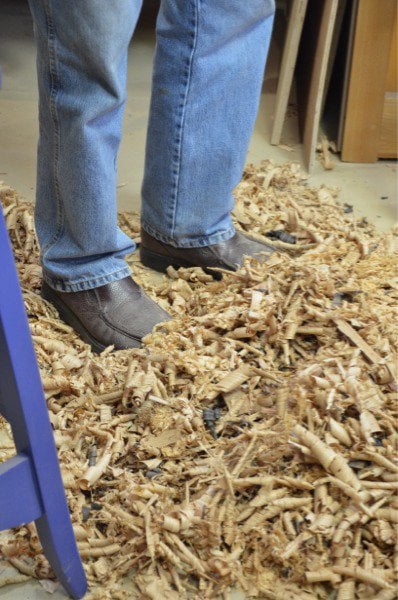
Mastering the plane and scraper elevates my quality of life and workmanship beyond measure and certainly higher than any machine can give me. One thing I have noticed with articles and chapters on scrapers is that there is more emphasis on two thumbs behind the scraper plate flexing the plate to task than reference to the heel of the hand flexing and powering the scraper, which in fact is far more practical and, in my day, used far more. I went to some top sites on scraper sharpening and using to further verify if what I was saying was so and was most surprised that they confirmed what I am saying. Some of these sites are by well-known gurus and others were reliable magazines and catalogue suppliers and so I carefully say I think they are sometimes a little imbalanced in what they present. So, here we go.
Working alongside the men I apprenticed with I learned much. One thing is that on larger surfaces and difficult grain you sharpen two or three scrapers when you start. That way, when they get hot, you drop the hot potato and pick up the next. Cycling through that way means you can cover a larger area without breaking of for cool down time and you have enough (12) cutting edges to work through instead of the usual 4. I stayed with this and it means less downtime and pretty much a fresh edge throughout the process.
As to the two thumbs aspect of using the burnisher. In the four videos I watched I actually did not see large fluffy shavings but minute ones and lots of dust and yet they were saying that when the scraper went dull you ended up with powder and little shavings. Exactly what they were getting. One video introduced a wide range of jigs to square the scraper edge and other none-essentials along the way to further confuse the very simple task of sharpening scrapers. Another filed the scraper at 90-degree across the scraper instead of draw-filing along the length, which makes straightening very difficult. In the end I felt so frustrated because again it was a crowded mass of miss-information that clouded the real truth. I must complete a series of videos on choosing, improving and using hand tools. To show which tools do what, which ones work and work well and how to get into the real power tools of woodworking, which have no tails and buttons to push. Soooon!!!
My scrapers are not to expensive and I recommend buying the set from Veritas. The hardness is perfect, the flex well to task, they retain their edge and take an edge readily. I have every type of scraper made I think and have used every maker type. Bahco scrapers are good too. The reason I like the Veritas set is that they are different thicknesses and different sizes. Here is the link. Get the scrapers only; plus a burnisher. Holders and edge formers are not really necessary and they slow down the development of skill and intuition, which speed up the whole process for me. Sorry Veritas.
The two-thumb method
Using two thumbs to flex and bow the plate is common and it works and works well. What I saw in the four videos fell far short of real power scraping. Yes I saw glistening surfaces but I couldn’t actually tell whether the surfaces were actually scraped or simply polished with the dull edge of the scraper; where the cutting edge actually never cut the wood but the roundover. Anyway, the long and short of it is this. No one referenced the fact that in general two-thumbs scraping is ideal on narrower boards where the knuckles of the hands hang either side of the workpiece and so give free access to adjusting the scraper height so that the optimality can be achieved to reach the exact cutting edge. With card scrapers, it is necessary to adjust the angle of presentation and change the trajectory to task. Many things affect this. I am not saying that two-thumbs will not work on wide boards, just that it is not always ideal. Where two-thumbs comes into its own is for localized flaws, edge work and minutely low spots. On tabletops and boards say wider than six inches, the heel-of-the-hand method is the single most effective if you are using a card scraper.
Heel-of-the-hand method
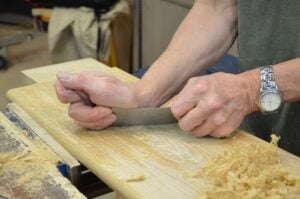
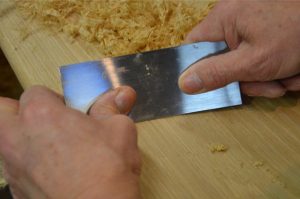


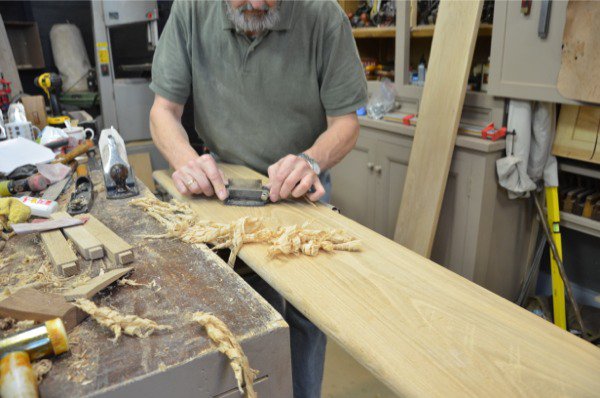
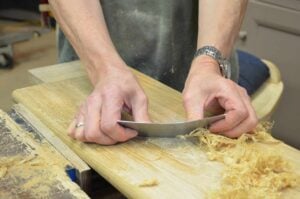
Free shipping from Lee Valley on orders over $40 for another week.
Can we expect a video demonstration soon? I’ve seen many on the two-thumbs method but have never heard of the heel method. As with many hand tool techniques, demonstration is the best teacher and we all appreciate your teachings much as you did when you were an apprentice!
Yes, soon.
If the video could discuss when to use the #80 and when to use the card scraper that would be helpful, since I would be inclined to just us the #80 on the bed. Also Could Joseph show us how to sharpen the #80 as well.
Paul, I’m building the tool chest project. Can a scraper be used on pine?
Yes, provided it is truly sharp and you are prepared to re sharpen frequently. Does this mean the plane is not working for you?
The plane is actually working really well, just getting tear-out on a certain part no matter what direction I plane. I have the frame all glued up and just cleaned up all the dovetails with the chisel using your paring method. Works amazing.
I can’t wait to make drawers and make your dovetail drawer handles. This project made me sign up. I have tools everywhere and nowhere to put anything. Gauges and engineer squares litter my workbench.
The main thing I am looking forward to is a project with veneer work. Your tool box with the veneer looks unbelievable. Here in New York on Long Island nobody has the faintest clue what real furniture looks like. They all buy that IKEA crap. I even fell victim to this. What I thought was furniture is heavy MDF. Total rip off.
I never even noticed until today, but being 33 years old, I walked into my 92 year old grandmothers house and her whole bedroom has chippendale furniture made 70 years ago. It is absolutely beautiful. There is barely no young generation that knows these skills. Hopefully the young individuals of today fill this void. Globalization has destroyed craftsmanship because all industry has been off-shored. I see it slowly coming back though. Here in New York the whole “Not Made In China” is really catching on. There is a huge market for quality especially among the young. Even the corporate food is looked down upon and instead organic fresh food supermarkets like Whole foods are popping up everywhere. It’s not a revolution that is taking place, it’s a restoration. People like you are a huge part of it’s success. Instead of looking up to Kim Kardashian, kids should look up to Thomas Edison. Hopefully that comes back.
Nice, Chris! Yes, I think there is a return to older traditions – and Paul, thank you for passing your knowledge on. I think there’s a terrible danger that we lose the true skills that have been passed on through hundreds of generations – today, we look for the cheaper, faster, alternative. It was brought home to me the other day – I haven’t touched wood for about 12 years and suddenly had to think, “How do I cut a mortise again?” So I did it with a drill bit and took ages – then later saw your video where you chopped two in a matter of minutes. It all came back to me – but it’s ridiculous how the mass of popular misinformation had clouded my memory.
I’m not sure about Edison. In pushing for the adoption of direct current, he ploughed a lot of time and money into the development of the electric chair – to prove how dangerous alternating current was. Nicola Tessla on the other hand (who used to work for Edison until he went to work for Westinghouse) was a true genius.
Using the heel of your hand is wonderful advice! I had an accident last week and lost the use of one of my fingers yet still had a project to complete. Using the heel of my hand was my only option and I stumbled on it by “accident”. It was so much easier, more consistent, and far leas fatiguing. Thanks for your sharing your own experiences!
I, too, have been reading the woodworking magazines and reading the hand tool blogs and forums (a lot!) over the past few years, and I’ve never seen the heel-of-the-hand method. I’ll have to try it out. I have noticed that a skewed cut with the scraper does result in a nice, long shaving. I think I figured that out by accident the other day while smoothing out a piece of black walnut.
You mention you can pull a scraper with the heel-of-the-hand method. I’m trying to wrap my mind around this based on your photo above. Care to elaborate?
The video we are making for woodworkingmasterclasses.com will help with technique.
Best to show via the video we are working on. Soooon!!!!!
Mr. Sellers, as far as the #80 cabinet scraper is concerned, what do you think of this little gizmo as an alternative?
http://www.leevalley.com/US/Wood/page.aspx?cat=1,310&p=32635
I just now noticed that Veritas makes this. It’s pretty affordable too, at least compared to the Vertias Cabinet Scraper (their version of the #80).
I don’t think this would be a good idea really. I don’t like scraper planes at all. They are always troublesome and they unnecessary as they do little if any more than plain old scraper.
Ok, understood. Thank you for the heads-up. 🙂
The Lie Nielsen 112 scraper plane is a delightful tool – manufactured to perfection – for finishing off large surface areas. Card scrapers and cabinet scraper become unpleasantly hot when used on dining table or kitchen tops. As an additional benfit, this plane comes ready to use with no need for any additional work to change its initial 45 degree bevel. For sharpening there is a clear and consice videio available; the rethorics of which is perhaps not state of the art, but whose content is easy to follow.
I appreciate you bringing this to the table, Sven. It is a good opportunity to help others understand a few points. Firstly I should ask you to consider something you said here and that is that cabinet scraper becomes unpleasantly hot. That’s not really the case any more than a scraper plane does. More mildly warm would be more accurate I think. This in no way affects the performance of the scraper and, because the hands don’t touch the blade ever, in use then, it makes no difference to the comfort levels of the user. It is perfectly comfortable to use. That being so, the only difference using this tool brings to any scraping task is the length of the sole in perhaps maintaining some level of flatness. If the wood is already flat then the regular #80 cabinet scraper will maintain flatness anyway, negating both the value and function of the more expensive scraper plane. A cabinet scraper is considerably less costly and will do everything any woodworker will want the scraper to do. A card scraper getting hot too is an easy soluble problem. Card scrapers cost almost nothing compared to the LN 112 scraper plane. Buying three card scrapers will give you twelve cutting edges to work with rather than just the one you get with the LN scraper plane and these will each hold their four cutting edges as long as the LN single edge, giving you at least four times the length of use. I say at least four times because the scraper is twice as wide so you may actually get as much as 8 times the work from each card scraper making this more efficient by as much as 24 times the LN one. Economics in time and outlay of finance is accomplished with the card scrapers. My reason for saying three card scrapers though is that you can get 3 for about £10-12. This means that each time the scraper builds up heat you change it out for a cool one and continue the work. It takes much time to remove the dulled blade from the LN 112 and then reinstall it. They are notably known for being more difficult to align to the sole face. Additionally, the fact the LN arrives sharp and ready to use bears no bearing on the continued use of the cutting edge which in general will be but a few minutes and no more than ten max. That being fact, the bevel of the blade does, as with all bevelled cabinet scrapers, need ongoing filing or grinding to prepare the beveled edge ready for consolidation and turning.
There are several different types of Veritas burnishers on Lee Valley, such as the variable burnisher and the tri-burnisher. Personally, it seems like the tri-burnisher has more flexibility, but which one would you recommend?
Yes, their tri burnisher works well with the larger radii of varying sizes and the small ones. You have the best of all worlds.
Looking forward to the video. This simple little rectangle of metal seems to be the most mysterious tool, getting a consistent edge.
I’d never heard of the palm technique before but I am pleased to discover it here. Despite being quite large & strong – or perhaps because of it -I have never felt happy using the 2 thumbs technique. It feels like it places a dangerous amount of pressure on the thumb joints that will inevitably lead to injury over time. That was my main motivation for buying and then learning to prepare & use my Stanley #80 cabinet scraper.
BTW I use English made Clifton card scrapers & burnisher, they seem good to me but I am no expert & have used no others. My sharpening technique for card scrapers is rather hit-or-miss – sometimes I get it right, sometimes not – having tried several methods described on youtube. I plan to try your method today! Thanks for sharing you experience 😉
Do you need an especially hard burnisher for the Veritas card scrapers, which are described as “super-hard” @ (Rc48-52) ? My carving tools/knives are typically RC59/60 – somewhat harder, so I’m thinking my Clifton burnisher is likely harder (yes, it is RC62).
For comparison, apparently my Clifton scrapers are somewhat softer: RC40/42.
Ref. https://www.classichandtools.com/acatalog/Clifton-Scrapers-and-Burnishers.html